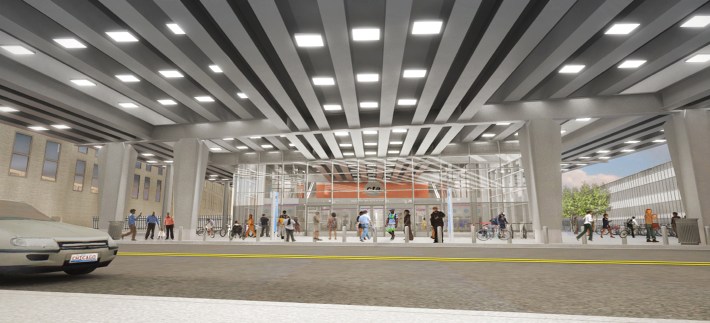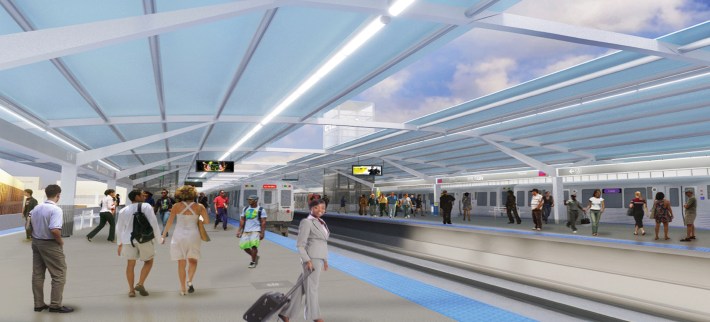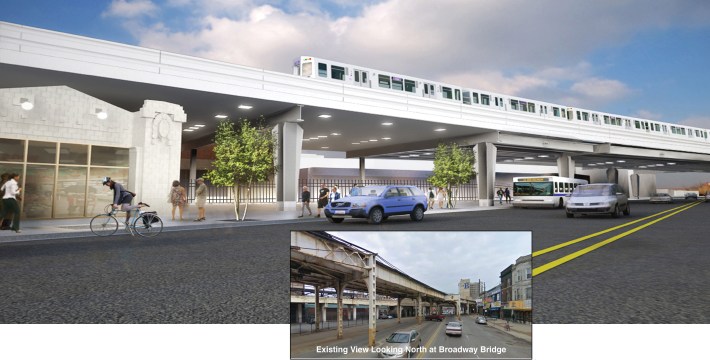At a community meeting Wednesday on the upcoming reconstruction of the Red Line’s Wilson stop, 46th Ward Alderman James Cappleman argued that one of the best things about the new station is that it will encourage walkable, transit-friendly development.
“One of the things I’ve pushed for as alderman is transit-oriented development, [which is a] good, sound urban planning practice,” he told residents during the hearing at Truman College. “We want to create more density closest to the ‘L’ stop.”
Cappleman noted that 45 percent of ward residents don’t own cars. “I am one of those people,” he said. “We also found that that 50 percent of the disposable income that you spend is spent outside the ward. So if we are going to make this a livable, walkable community, we need to make sure you can do your shopping here. “
He added that the ward has been working with the mayor’s office and various city departments on strategies to fill empty storefronts near the station. “From my discussions with many developers, they are banging on the doors wanting to do something, so you’re going to see some exciting things, and it’s because of this Wilson ‘L’ stop,” Cappleman said. “The trick is making sure that, while we do that, we keep [the ward] as diverse as possible.”
At the meeting, officials updated residents on construction plans for the $203 million project, a massive overhaul of a station that RedEye readers have thrice voted Chicago’s grungiest. Originally built in 1923, the station has badly deteriorated over the last century, and it is not ADA accessible.
The new station will function as an additional transfer point between the Red and Purple lines, which means Uptown residents will be able to catch the Evanston Express for a faster ride downtown or to Evanston during rush hours. To accommodate Purple Line service, there will be two different “island” platforms, with canopies to shelter riders from the elements.
There are currently two entrances to the station, at the Wilson/Broadway intersection, and a third will be added a block south at Sunnyside. Two out of the three entrances will be accessible to people in wheelchairs. As part of the project, ‘L’ pillars along Broadway will be relocated to improve sightlines and create a less gloomy atmosphere under the tracks.
Historic preservationists at the hearing said they were glad that the CTA will restore the historic Gerber building at the northwest corner of Wilson/Broadway, including rebuilding its long-demolished clock tower. However, some expressed displeasure that the old Majestic Men’s Wear building, 4701 North Broadway, will be demolished to make way for the station’s new main entrance, although the vintage façade will be incorporated into the station design.
The project is slated for completion by fall 2017, and the station will remain open during the work. Pre-construcution will start next month, including relocation of some utilities, foundation work, and demolition of the menswear building, an unused freight structure, a CTA carpenter shop, and the Broadway Mall. Work on the new station will begin this spring. View a full explanation of the construction schedule here.
When the floor was opened to questions, neighbors asked about minority participation in the construction work, the possibility of installing artwork by locals in the station, and what steps are being taken to reduce crime in the vicinity of the ‘L’ stop. On the last topic, Cappleman noted that the design includes additional fencing, brighter lighting, and the installation of over 100 security cameras.
One resident thanked Cappleman for pushing the CTA and the mayor’s office to get the station rehabbed, then asked about plans for dealing with rats who will be dispersed during the demolition work. “A lot of these buildings have been empty for many years, and there’s probably lots of vermin ready to scurry into my neighborhood.”
“We’re very aware of rat situation underneath the ‘L’ and the Gerber Building,” responded CTA staffer Jeffrey Wilson. “So we’re going to have a pre-construction rat abatement, during-construction rat abatement, post-construction rat abatement, and whenever-the-community-wants-rat-abatement rat abatement.”








